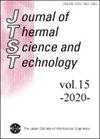Study on energy consumption model of multi-unit air conditioning system with digital scroll compressor
IF 0.9
4区 工程技术
Q3 THERMODYNAMICS
引用次数: 1
Abstract
The objectives of this study were to: (i) build simulation model for mult-unit air conditioning (AC) system with digital scroll compressor (DSC) and validate its precision by experiments; (ii) build system energy consumption calculation model by simulation. Lumped parameter model of compressor and electronic expansion valve, and district lumped parameter model of condenser and evaporator were employed in simulation program of multi-unit AC system with DSC. The results indicated that errors between simulated value and experimental data of system hourly energy consumption were within 10%. The simulation model showed good precision. Simulation results indicated that system hourly energy consumption differences caused by indoor unit operating number were less than 15%, which can be neglected. Thus, hourly energy consumption (HW), hourly energy efficiency ratio (HEER) and hourly heating performance factor (HHPF) calculation model of multi-unit AC system with DSC were built based on simulation results. Simulation results indicated that the variation of HW with part load ratio (PLR) and outdoor air temperature presented concave surface distribution and the variations of HEER and HHPF with PLR and and outdoor air temperature presented convex surface distribution. The model provides a tool for energy saving optimization and seasonal energy consumption evaluation of multi-unit AC system with DSC.数字涡旋压缩机多机组空调系统能耗模型研究
本研究的目的是:(1)建立带有数字涡旋压缩机(DSC)的多机组空调系统的仿真模型,并通过实验验证其精度;(ii)通过仿真建立系统能耗计算模型。在多机组交流系统的DSC仿真程序中,采用压缩机和电子膨胀阀的集总参数模型以及冷凝器和蒸发器的区域集总参数模型。结果表明,系统小时能耗模拟值与实验数据误差在10%以内。仿真模型显示了较好的精度。仿真结果表明,室内机运行次数对系统小时能耗的影响小于15%,可以忽略不计。基于仿真结果,建立了带DSC的多机组交流系统时能耗(HW)、时能效比(HEER)和时采暖性能因子(HHPF)计算模型。仿真结果表明,HW随部分载荷比(PLR)和室外空气温度的变化呈凹面分布,HEER和HHPF随PLR和室外空气温度的变化呈凸面分布。该模型为多机组DSC交流系统的节能优化和季节性能耗评价提供了工具。
本文章由计算机程序翻译,如有差异,请以英文原文为准。
求助全文
约1分钟内获得全文
求助全文
来源期刊
CiteScore
2.30
自引率
8.30%
发文量
0
审稿时长
5 months
期刊介绍:
JTST covers a variety of fields in thermal engineering including heat and mass transfer, thermodynamics, combustion, bio-heat transfer, micro- and macro-scale transport phenomena and practical thermal problems in industrial applications.

 求助内容:
求助内容: 应助结果提醒方式:
应助结果提醒方式:


